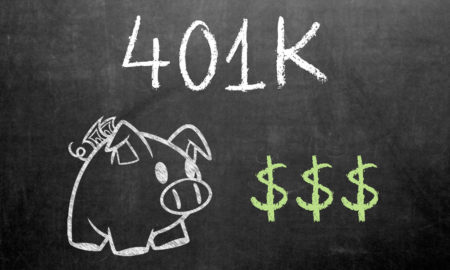

Deprecated: Implicit conversion from float 1757906444.006673 to int loses precision in /www/investmentzen_357/public/blog/wp-content/plugins/intelly-related-posts/includes/classes/utils/Logger.php on line 93
Deprecated: Implicit conversion from float 1757906444.00869 to int loses precision in /www/investmentzen_357/public/blog/wp-content/plugins/intelly-related-posts/includes/classes/utils/Logger.php on line 93
401(k)s are the primary way that Americans save for retirement. With their high contribution limits, tax advantages, and the benefits that employers offer to employees that contribute to their 401(k)s it’s no surprise that they’re so popular.
One thing that confuses many people who have a 401(k) plan is the concept of 401(k) vesting, both what it is and how it works.
What is a 401(k)?
To understand 401k vesting, you need to know what a 401(k) is. Put simply, it’s a type of account offered by employers that employees can use to save for retirement.
Generally, the money you contribute to a 401(k) is invested in mutual funds that hold stocks and bonds. Though there is risk when you invest money in stocks and bonds, the long length of time you have to invest over the course of your career means that you’ll almost always come out ahead.
To encourage people to contribute to 401(k)s, the government allows you to deduct the amount of money you contribute from your taxable income. That means that every dollar you contribute reduces your paycheck by less than a dollar. Instead, your money is taxed when it is withdrawn from the 401(k) during retirement.
Because 401(k)s are offered by employers as a benefit for employees, your employer will often contribute to the account on your behalf. Generally, employers will match your contributions, up to a certain percentage of your total salary.
As an example, your employer may offer a 100% match on up to 5% of your salary. That means if you make $50,000 a year and contribute $2,500, your employer will contribute $2,500 as well. If you contribute more than $2,500, you employer will still contribute $2,500, but if you put in less, the amount your employer adds will also be less. Contributing enough money to your 401(k) to get the full match your employer provides is like getting money for free.
In 2020, you can contribute up to $19,500 per year to a 401(k). If you’re over 50 years old, you can add an extra $6,500. Employer contributions don’t apply to these limits.
What is 401(k) Vesting?
401(k)s are one of the ways that employers attract talent to join the company. Offering a generous match can be very attractive to people who are saving for their retirement.
401(k)s are also used to keep employees from leaving the company. When you receive a matching contribution from your employer, you don’t technically own the money. You can invest it, but the money remains the employer’s property.
After certain requirements are met, you become vested in the plan. Any previous and future contributions that your employer makes become your property once you are vested.
If you leave your job, any money that hasn’t vested still belongs to your employer and will be removed from your 401(k). Any money that has vested will stay in the account for you to use.
How Do I Get My Money to Vest in my 401k?
How you get your employer’s contributions to your 401(k) to vest depends on how the company’s vesting schedule is designed. There are three main types of vesting, all of which depend on how long you’ve worked for the company.
Immediate Vesting
The best type of vesting for employees is what is called immediate vesting. Like the name implies, any money your employer contributes is immediately vested and cannot be taken away. Even if you only receive one paycheck from the employer, you get to keep the matching money they’ve deposited for you.
Graded Vesting
Another type of vesting is called graded vesting. In this system, portions of your employer’s contributions vest each year until all the money your employer contributes is vested. For example, if your employer has contributed $10,000 to your 401(k) by the time you leave your job, and you are 40% vested in the plan, you’ll get to keep $4,000. The other $6,000 will be returned to the company.
According to law, the least generous graded vesting plan allows employers to vest only 20% of contributions per year, starting two full years after you’ve started your job. If you leave your job before two years have passed, you’ll keep none of the employer contributions. Between two and three years you’ll keep 20%, between three and four years you’ll keep 40%, and on until you are fully vested after working for six years. Employers are welcome to have the vesting occur more quickly, such as 50% vesting after one year and full vesting after two.
The advantage of this system is that you will vest in the plan over time, so if you leave your job after a few years you’ll get to keep the contributions. The downside is that long vesting schedules make it likely you’ll have to give some of the money back.
Cliff Vesting
Cliff vesting is the final vesting schedule an employer can offer. It’s an all or nothing system: you’re either 0% vested or 100% vested. Under IRS rules, you must be vested after a maximum of three years of employment, though your employer may offer a shorter vesting schedule if desired.
The advantage of this system is that you know exactly how much money is yours at all times. You also have a shorter waiting period to become fully vested. On the downside, if you leave before you vest in the plan, you’ll have to forfeit all of your employer’s contributions.
Understanding 401(k) vesting is essential to making the right decision when deciding how much to contribute and considering career changes.
A Note On Uncovering Hidden Fees In Your 401(k) Investments
Most of us greatly under-estimate the impact that fees can have on our retirement. Thanks (or no thanks) to the power of compound interest, even a seemingly harmless 0.5% difference in fees can cost you hundreds of thousands of dollars and delay your retirement by many years.
When InvestmentZen contributor Mr. 1500 ran Personal Capital’s fee analysis tool on his 401k portfolio, he was shocked by what he discovered. The free analysis showed that with his current portfolio, he was on track to paying a whopping $594,993 in fees over the next 26 years and losing 3 years of retirement, due entirely to hidden fees:
After making this discovery, it only took him a few hours of adjusting his portfolio with the help of Personal Capital’s fee analyzer to reduce his potential fees to just $86,163, saving him over $500,000 dollars and shaving 2 years from his path to retirement.
If you want to get the most out of your 401(k) investments, signing up for a free account at Personal Capital to take advantage of their free investment fee analyzer is an easy way to do it.
It could potentially save you $500,000 dollars (or more).
And did we already mention its 100% free?
Photo credit: InvestmentZen Images – Creative Commons Attribution License




















